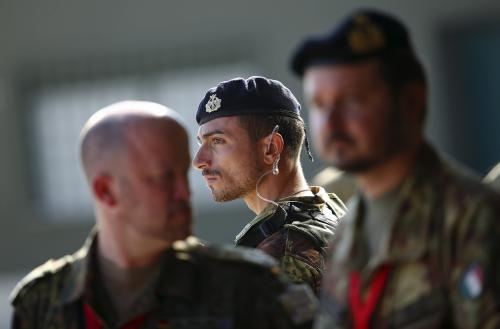The National Security Strategy and National Defense Strategy call for an increased focus on great power competition, and as experts discussed at a recent event, the U.S. Navy will play a crucial role in that regard. On January 28, Admiral John Richardson—the 31st chief of naval operations—delivered a keynote at Brookings on the Navy’s new operational guidance and outlined the Navy’s goals to grow and modernize its fleet, as well as address shortfalls in operational readiness. Afterwards, Senior Fellow and Director of Research for the Foreign Policy program Michael O’Hanlon engaged in a dialogue with Admiral Richardson.
To address increasingly complex security challenges, Richardson said that the Navy must restore conceptual, geographic, and technological agility. Conceptual agility recognizes the growing role of information in military operations. Geographic agility recognizes the importance of being present—Richardson recounted that the Navy sent a strike group north of the Arctic Circle last fall for the first time since 1991. And technological ability recognizes that the United States must not be dominated by a rival that can get technology to its forces faster. Richardson brought up the Navy’s role in missile defense, observing that its ships sail in “small boxes” to protect land assets, when they could be put to use in other theaters, such as the South China Sea and the North Atlantic. In the context of technological change, he also discussed the prospects of directed-energy weapons, among other systems.
After his presentation of the Navy’s updated operational guidance, O’Hanlon asked Richardson to provide his “30,000-foot view” of the state of today’s Navy, particularly in light of the various readiness problems it faced in 2017 and earlier. Richardson said: “We’re in a good place.” He highlighted recent visits to the Fifth, Sixth, and Seventh Fleets, and reported that readiness and rigor have returned across the board. While there are still readiness issues to address, he asserted that the Navy is on the right track.
Asked how the general political and fiscal turbulence in Washington affect operational planning, Richardson observed that the Navy is particularly susceptible to budget turbulence, so it will continue to advocate for as much predictability and stability as it can. But in recent weeks, Acting Secretary of Defense Patrick Shanahan’s guidance has been “steady as she goes,” and the Navy has acted accordingly.
O’Hanlon then asked Richardson about which kinds of technology he’s most excited and/or nervous about, with respect to the opportunities and vulnerabilities laid out in the Navy’s operational concept. Richardson highlighted the ethical and operational challenges of autonomous vehicles, as well as the growing challenges of artificial intelligence and how to infuse it across the Navy, from sensors to decision centers. Overall, he did not identify any major technology area where the United States could not compete well—and he also underscored the survivability of the aircraft carrier compared with stationary land bases, given its ability to move some 720 miles in any 24-hour period.
O’Hanlon raised the official Navy position that its fleet needs 355 ships—up from its current count of 284—to adequately fulfill its mission, asking Richardson whether the rapid pace of technological change makes it difficult to envision what a fleet in the year 2040 or 2050 ought to look like. Richardson responded that the 355 figure was the result of studies that identified the number of ships the Navy said it needed in its 2016 Force Structure Assessment to meet its responsibilities. Without committing to a given fleet design, Richardson argued that the nation clearly needed more naval power, and that we should continue building it even as we debate and adjust future procurement plans.
Finally, O’Hanlon brought up Richardson’s recent trip to China, during which he met with his counterpart in the People’s Liberation Army Navy (PLAN). Given growing U.S.-China tensions—a considerable portion of which is evident in the maritime domain—O’Hanlon asked Richardson for any reassuring message that he could bring from his trip. Richardson reported that he has a “good working relationship” with his PLAN counterpart, which makes possible a range of exchanges and communications that allow both sides to gain a better understanding of the other’s intent. While Richardson conceded that the United States and China are in competition with each other, as China continues to grow, there will be areas where the two powers have common interests. Also, the mutual interest in increasing prosperity for both nations is an area of opportunity to induce communication and cooperation where possible.
With respect to the South China Sea, where Richardson stressed that “our understanding of [this area] and those sorts of things are just at odds right now,” there is an “operational arrangement” for when the war ships of both nations meet, a code of unplanned encounters that allows the United States and China to pass as two ships, without increasing risk. He said “as we navigate and resolve those differences, we’ve got to do so in a way that minimizes risk,” while imploring the PLAN (as well as China’s coast guard and maritime militia) to comply with international law on encounters at sea.
During the Q&A, an audience member asked Richardson about the Navy’s role in any future crisis involving Taiwan, mentioning that two U.S. ships recently passed through the Taiwan Strait. Richardson observed that the waters they went through were international, and conducted themselves professionally. Another audience member asked if he saw any tensions with the Iranian Navy after redeploying the USS Stennis back to the region, and Richardson said that the U.S. Navy’s presence was within historical norms, and that there is “really nothing to be too concerned about in terms of the response of the Iranian Navy.”



Commentary
The chief of naval operations talks technology, China, and more
February 4, 2019